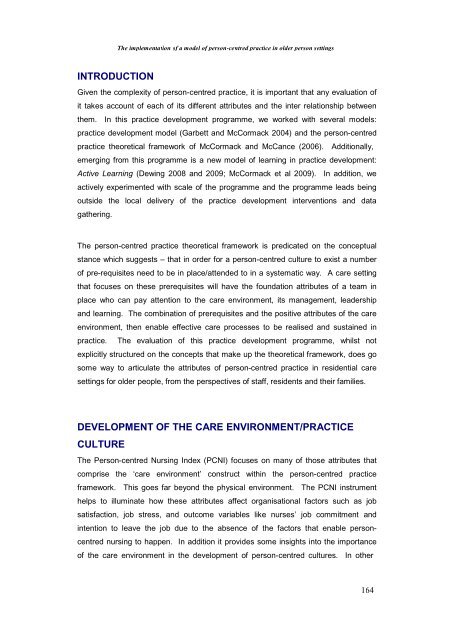The Implementation of a Model of Person-Centred Practice In Older ...
The Implementation of a Model of Person-Centred Practice In Older ...
The Implementation of a Model of Person-Centred Practice In Older ...
You also want an ePaper? Increase the reach of your titles
YUMPU automatically turns print PDFs into web optimized ePapers that Google loves.
<strong>The</strong> implementation <strong>of</strong> a model <strong>of</strong> person-centred practice in older person settings<br />
INTRODUCTION<br />
Given the complexity <strong>of</strong> person-centred practice, it is important that any evaluation <strong>of</strong><br />
it takes account <strong>of</strong> each <strong>of</strong> its different attributes and the inter relationship between<br />
them. <strong>In</strong> this practice development programme, we worked with several models:<br />
practice development model (Garbett and McCormack 2004) and the person-centred<br />
practice theoretical framework <strong>of</strong> McCormack and McCance (2006). Additionally,<br />
emerging from this programme is a new model <strong>of</strong> learning in practice development:<br />
Active Learning (Dewing 2008 and 2009; McCormack et al 2009). <strong>In</strong> addition, we<br />
actively experimented with scale <strong>of</strong> the programme and the programme leads being<br />
outside the local delivery <strong>of</strong> the practice development interventions and data<br />
gathering.<br />
<strong>The</strong> person-centred practice theoretical framework is predicated on the conceptual<br />
stance which suggests – that in order for a person-centred culture to exist a number<br />
<strong>of</strong> pre-requisites need to be in place/attended to in a systematic way. A care setting<br />
that focuses on these prerequisites will have the foundation attributes <strong>of</strong> a team in<br />
place who can pay attention to the care environment, its management, leadership<br />
and learning. <strong>The</strong> combination <strong>of</strong> prerequisites and the positive attributes <strong>of</strong> the care<br />
environment, then enable effective care processes to be realised and sustained in<br />
practice. <strong>The</strong> evaluation <strong>of</strong> this practice development programme, whilst not<br />
explicitly structured on the concepts that make up the theoretical framework, does go<br />
some way to articulate the attributes <strong>of</strong> person-centred practice in residential care<br />
settings for older people, from the perspectives <strong>of</strong> staff, residents and their families.<br />
DEVELOPMENT OF THE CARE ENVIRONMENT/PRACTICE<br />
CULTURE<br />
<strong>The</strong> <strong>Person</strong>-centred Nursing <strong>In</strong>dex (PCNI) focuses on many <strong>of</strong> those attributes that<br />
comprise the ‘care environment’ construct within the person-centred practice<br />
framework. This goes far beyond the physical environment. <strong>The</strong> PCNI instrument<br />
helps to illuminate how these attributes affect organisational factors such as job<br />
satisfaction, job stress, and outcome variables like nurses’ job commitment and<br />
intention to leave the job due to the absence <strong>of</strong> the factors that enable personcentred<br />
nursing to happen. <strong>In</strong> addition it provides some insights into the importance<br />
<strong>of</strong> the care environment in the development <strong>of</strong> person-centred cultures. <strong>In</strong> other<br />
164
















